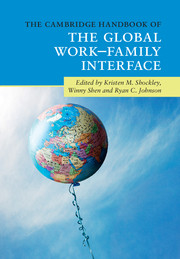Book contents
- The Cambridge Handbook of the Global Work–Family Interface
- The Cambridge Handbook of the Global Work–Family Interface
- Copyright page
- Contents
- Figures
- Tables
- Contributors
- Part I Overview
- Part II Assessing Cultural and Structural Differences
- Part III Methodological Considerations
- Part IV Review of Research in Regions across the Globe
- 13 A Review of Work–Family Research in Western and Southern Europe
- 14 A Review of Work–Family Research in Central and Eastern Europe
- 15 A Review of Work–Family Research in the Nordic Region
- 16 A Review of Work–Family Research in Latin America
- 17 A Review of Work–Family Research in Africa
- 18 A Review of Work–Family Research in the Middle East
- 19 A Review of Work–Family Research in South East Asia
- 20 A Review of Work–Family Research in Confucian Asia
- 21 A Review of Work–Family Research in Australia and New Zealand
- Part V Cultures within Cultures
- Part VI Organizational Perspectives
- Part VII Family Perspectives
- Part VIII Individual Perspectives
- Part IX Conclusion
- Index
- References
18 - A Review of Work–Family Research in the Middle East
from Part IV - Review of Research in Regions across the Globe
Published online by Cambridge University Press: 16 April 2018
- The Cambridge Handbook of the Global Work–Family Interface
- The Cambridge Handbook of the Global Work–Family Interface
- Copyright page
- Contents
- Figures
- Tables
- Contributors
- Part I Overview
- Part II Assessing Cultural and Structural Differences
- Part III Methodological Considerations
- Part IV Review of Research in Regions across the Globe
- 13 A Review of Work–Family Research in Western and Southern Europe
- 14 A Review of Work–Family Research in Central and Eastern Europe
- 15 A Review of Work–Family Research in the Nordic Region
- 16 A Review of Work–Family Research in Latin America
- 17 A Review of Work–Family Research in Africa
- 18 A Review of Work–Family Research in the Middle East
- 19 A Review of Work–Family Research in South East Asia
- 20 A Review of Work–Family Research in Confucian Asia
- 21 A Review of Work–Family Research in Australia and New Zealand
- Part V Cultures within Cultures
- Part VI Organizational Perspectives
- Part VII Family Perspectives
- Part VIII Individual Perspectives
- Part IX Conclusion
- Index
- References
Summary
- Type
- Chapter
- Information
- The Cambridge Handbook of the Global Work–Family Interface , pp. 337 - 351Publisher: Cambridge University PressPrint publication year: 2018

